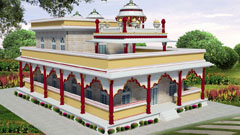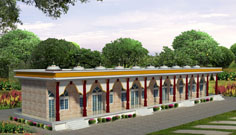Tirth
What is Tirth:
Tirth is a way that helps to overcome the perpetual wheel of birth & death, to come out from the mesh of worldly affairs and to get free from mundane afflictions. All the 24 Tirthankaras have shown this way in practical in their life, by precepts (Education) delivered by them in Samavsharana. They are also called Jina, because they have won the Karma, both the external & internal – the Bhav Karma (affection & aversion, anger, proud, greed etc.) and attained the salvation, full and final liberation from world.
So the entire life of Jina & their precepts are also called Tirth.
In ‘Yuktyanushasan’ Acharya Samantabhadra says that the Tirth of Jina is auspicious to all (Sarvodaya). He says in ‘Brihat Swayambhu Stotra’ praying to Bhagwan Mallinath (The 19th Tirthankara) that your Tirth brings out all the living beings from the ocean of birth & death.
In the same way, the places related to the Garbha, Janma, Deeksha, Gyan (Jnan) & Moksha Kalyanakas of various Tirthankaras and places where an ascetic saint attained Kevalgyan or salvation are also called Tirth being sacred due to contact of those holy persons.
Acharya Vadeebha Singh Suri says that due to the contact of great persons places also becomes sacred. Such sacred places are called Tirths or Tirth Kshetras.
Reasons of establishment of the Tirths :
Tirthankaras and various ascetic saints have practiced penance, meditation, self-control etc. to get free from the worldly troubles of birth, old age & death and they show the path to world to get rid of these troubles.
In this way, those are well wishers of world without any reason or expectations. Only due to this reason they are called the headers of Moksha Marga (The path of salvation).
To show the gratefulness about their beneficence, to keep the spiritual event of that place in continuous memory and by all this, to experience the properties of those Tirthankaras and ascetic saints, a memorial is built there by their followers or devotees.
The feelings of gratefulness are the main reason in construction or establishment of all the Tirth Kshetras in the world.
Types of Tirths:
Jains accept the three types of Tirth Kshetras as under –
1. Nirvan Kshetra or Siddha Kshetra –
The places of salvation of any Tirthankara or an ascetic saint or more. In world preaches of all the sacred texts, Vrata, Tapa, penance, meditation; all are aimed to get freedom from world. This is the only & final object of human pursuit.
So the place of salvation becomes sacred. After salvation Gods of heaven (Dev) come there for worship. Indra (The King of heaven) makes a symbol at that place. Followers or devotees place the images of feet there to memorize the event.
Devotion & faith of public towards Nirvan Kshetras is always greater than other Tirth Kshetras.
Kailashgiri, Sammed Shikhar, Champapur, Pavapur, Girnargiri are the places of salvation related to Tirthankaras.
Mangi-Tungi, Sonagiri, Muktagiri etc. are other Nirvan Kshetras related to ascetic saints other than Tirthankaras.
2. Kalyanaka Kshetra – These are the places related to Garbha (Conception), Janma (Birth), Tapa / Deeksha (Accepting the penance), Gyan (Knowledge) Kalyanakas of Tirthankaras. Some of such places are Hastinapur, Ayodhya, Shauripur etc.
3. Atishaya Kshetra – Such Tirth Kshetras where a miracle or wonder is happened or seen about the temple, idol or place are known as Atishaya Kshetra. Some of famous Atishaya Kshetras are Shri Mahaveerji, Tijara, Padampura, Hummacha, Gopachal, Khajuraho etc.
The places other than Nirvan Kshetra or Kalyanka Kshetra are all called Atishaya Kshetra.
In beginning, generally only the footprints or foot images were kept on Tirth Kshetras and one or two temples were built there. Later on the importance of temples felt more, so many temples were constructed at Tirth Kshetras. In ancient times Stoopa, Ayaga Patta, Dharma Chakra and Tirthankar idols with Ashta Pratiharya were built & installed there and they were supposed the unique & essential parts of Jain Art, after 11th-12th century these became uncommon. Now a day Tirthankara idols are carved alone, expressing the sentiments of eternal piece and non affection beautifully and in impressive manner.
Importance of Tirth Kshetras:
Digambar Jain Tirth Kshetras have a great existence in Indian Culture. Kalyanaka Kshetras related to Tirthankaras and salvation places of Tirthankaras & ascetic saints getting sacred by their Tapa (Penance) & practice of self-control are the symbols of ever existing faith in religion of Indian Public.
These Kshetras give the message of eternal piece and religiousness to human beings, who are trapped in the mesh of worldly affairs and troubles of life. Tirth gives the message of non-violence, truth, non attachment without speaking and thus brings the man on right path.
Utility of Tirth Kshetras in real is this, that reaching there, inclination towards worldly worries & responsibilities gets vanished, intension is diverted towards self-realization due to devotion in those great persons / saints. At home one never gets freedom from family work & responsibilities. Tirth Kshetras exist far away from the noise of cities in forests or on hills in peaceful environment, so the mind of a man being free from tension & trouble gets engaged in worship of god and in self-realization.
Explaining the efficacy of Tirth Kshetras, it is said – The dust of path of Tirth Kshetras is so sacred that by taking shelter of that some one gets freedom from Karma. By pilgrimage of Tirths, the wheel of birth & death is left behind. By expending money on Tirths, money becomes never lasting, by taking shelter of God e.g. by following the path of Tirthankaras (Ratna Traya) in life, some one also becomes worshipable by world.























